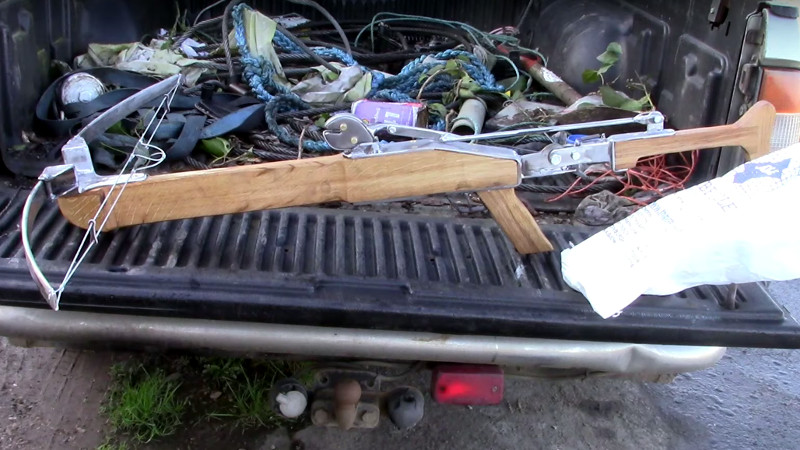The would-be invader of a mediaeval kingdom could expect to face some stern opposition from a variety of formidable weaponry. Making modern versions of these deadly curiosities seems to be a popular pursuit, and the bug has bitten [Turbo Conquering Mega Eagle], who’s created what he calls a “Stonebow”, a crossbow on steroids that fires stones or large ball bearings with considerable force.
It uses a couple of leaves from automotive springs, mounted in a welded steel riser with two strings and a pouch for the projectile. The barrel is an oak fencing post, and at its other end is a cocking lever which also forms a stock, and a cleverly designed trigger mechanism. The projectile is loaded, the bow is cocked, and it is fired at a scrap Land Rover radiator in which it places a satisfying impact mark.
Despite two successful firings it’s evident that so much force isn’t easy to contain. The crimps that secure the strings aren’t up to the job, and neither is the oak fence post, which has cracked at the end. We trust that our Essex hacker friend will return having fixed these flaws, and more defenceless scrap car parts will be sacrificed for our entertainment.
We’ve featured [Turbo Conquering Mega Eagle] before, most recently building a mini-bike for his youngsters. Meanwhile, enjoy the Stonebow in the video below the break.















there where mainly hunting crossbows like that during XV-XVII centuries. Bolts are better for heavier targets but on light game birds rabbits and so on round ball is good.
I always had the impression it was nothing to do with ‘better’ for target type. But more the power of the war crossbows requiring a more aerodynamically controlled, heavy and notched projectile to work properly. Where the balls work fine on longer draw low power bows – the lower acceleration doesn’t make the ball’s inertia exceed the control the of the string and stock so it fires in the right direction.
I’ve got a book somewhere that I’m sure was saying something along those lines, and it seems quite reasonable to me. But it or I could be wrong, if so any references would be interesting.
<>
“Fetchez la vache!”
The current solution lacks security measures even medieval crossbows had.
With the butt-based drawing mechanism the locking may fail. This would probably result in the whole crossbow smashing into the archers face. Another point of failure is already mentioned: Steel may bend, so you won’t attach two different rotation points to a single wooden structure. Medival crossbows solved this by attaching the throwing arm at only one single point, allowing it to bend and rotate freely.
Another subject is throwing balls without any guarding machanism. If anything becomes unbalanced the ball smashes against the throwing arms.
Hand protection (against broken string) and a release which stays at a fixed position may also be worth of thinking ’bout.
I’m pretty sure that the butt is only under tension during the drawing process and therefor is no more dangerous than any other lever drawing method.
Here in America, we use OCS* steel for our crossbows.
*Old Chevy Spring
It does not “fire”. It launches.
If you want to make your own, there are also lots of good resources here: https://crossbow.fandom.com/wiki/Making_a_steel_prod_from_a_leaf_spring